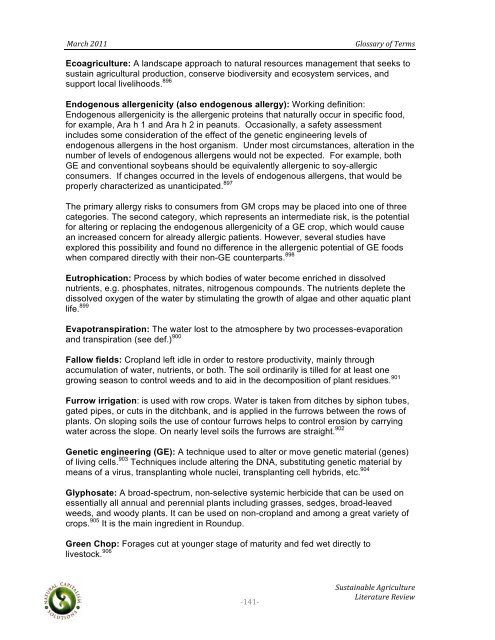Sustainable Agriculture Literature Review - Boulder County
Sustainable Agriculture Literature Review - Boulder County
Sustainable Agriculture Literature Review - Boulder County
You also want an ePaper? Increase the reach of your titles
YUMPU automatically turns print PDFs into web optimized ePapers that Google loves.
! !!<br />
"#$%&!'())!! !!!!!!!!!!!!!!!!!!!!!!!!!!!!!!!!!!!!!!!!!!!!!!!!!!!!!!!!!!!!!!!!I/-44#$F!-J!K1$B4!<br />
Ecoagriculture: A landscape approach to natural resources management that seeks to<br />
sustain agricultural production, conserve biodiversity and ecosystem services, and<br />
support local livelihoods. 896<br />
Endogenous allergenicity (also endogenous allergy): Working definition:<br />
Endogenous allergenicity is the allergenic proteins that naturally occur in specific food,<br />
for example, Ara h 1 and Ara h 2 in peanuts. Occasionally, a safety assessment<br />
includes some consideration of the effect of the genetic engineering levels of<br />
endogenous allergens in the host organism. Under most circumstances, alteration in the<br />
number of levels of endogenous allergens would not be expected. For example, both<br />
GE and conventional soybeans should be equivalently allergenic to soy-allergic<br />
consumers. If changes occurred in the levels of endogenous allergens, that would be<br />
properly characterized as unanticipated. 897<br />
The primary allergy risks to consumers from GM crops may be placed into one of three<br />
categories. The second category, which represents an intermediate risk, is the potential<br />
for altering or replacing the endogenous allergenicity of a GE crop, which would cause<br />
an increased concern for already allergic patients. However, several studies have<br />
explored this possibility and found no difference in the allergenic potential of GE foods<br />
when compared directly with their non-GE counterparts. 898<br />
Eutrophication: Process by which bodies of water become enriched in dissolved<br />
nutrients, e.g. phosphates, nitrates, nitrogenous compounds. The nutrients deplete the<br />
dissolved oxygen of the water by stimulating the growth of algae and other aquatic plant<br />
life. 899<br />
Evapotranspiration: The water lost to the atmosphere by two processes-evaporation<br />
and transpiration (see def.) 900<br />
Fallow fields: Cropland left idle in order to restore productivity, mainly through<br />
accumulation of water, nutrients, or both. The soil ordinarily is tilled for at least one<br />
growing season to control weeds and to aid in the decomposition of plant residues. 901<br />
Furrow irrigation: is used with row crops. Water is taken from ditches by siphon tubes,<br />
gated pipes, or cuts in the ditchbank, and is applied in the furrows between the rows of<br />
plants. On sloping soils the use of contour furrows helps to control erosion by carrying<br />
water across the slope. On nearly level soils the furrows are straight. 902<br />
Genetic engineering (GE): A technique used to alter or move genetic material (genes)<br />
of living cells. 903 Techniques include altering the DNA, substituting genetic material by<br />
means of a virus, transplanting whole nuclei, transplanting cell hybrids, etc. 904<br />
Glyphosate: A broad-spectrum, non-selective systemic herbicide that can be used on<br />
essentially all annual and perennial plants including grasses, sedges, broad-leaved<br />
weeds, and woody plants. It can be used on non-cropland and among a great variety of<br />
crops. 905 It is the main ingredient in Roundup.<br />
Green Chop: Forages cut at younger stage of maturity and fed wet directly to<br />
livestock. 906<br />
!<br />
"'*'"<br />
!,342#.5#6/1!78$.%3/23$1!<br />
9.21$#23$1!:1;.1
















